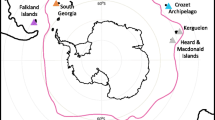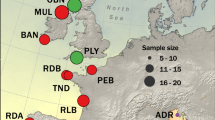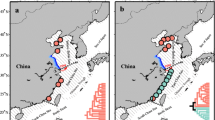Abstract
The marine species usually show high dispersal capabilities accompanied by high levels of gene flow. On the other hand, many physical barriers distribute along the continental marginal seas and may prevent dispersals and increase population divergence. These complexities along the continental margin generate serious challenges to population genetic studies of marine species. Chinese sea bass Lateolabrax maculatus distributes broad latitudinal gradient spanning from the tropical to the mid-temperate zones in the continental margin seas of the Northwest Pacific Ocean. Using the double digest restriction-site-associated DNA tag sequencing (ddRAD) approach, we genotyped 10,297 SNPs for 219 Chinese seabass individuals of 12 populations along the Chinese coast in the Northwest Pacific region. Genetic divergence among these populations was evaluated, and population structure was established. The results suggested that geographically distant populations in the Bohai Gulf and the Beibu Gulf retain significant genetic divergence, which are connected by a series of intermediate populations in between. The results also suggested that Leizhou Peninsula, Hainan Island, and Shandong Peninsula are major physical barriers and substantially block gene flow and genetic admixture of L. maculatus. We also investigated the potential genetic basis of local adaptation correlating with population differentiation of L. maculatus. The sea surface temperature is a significantly differentiated environmental factor for the distribution of L. maculatus. The correlation of water temperature and genetic variations in extensively distributed populations was investigated with Bayesian-based approaches. The candidate genes underlying the local selection in geographically divergent populations were identified and annotated, providing clues to understand the potential mechanisms of adaptive evolution. Overall, our genome scale population genetic analysis provided insight into population divergence and local adaptation of Chinese sea bass in the continental marginal seas along Chinese coast.






Similar content being viewed by others
References
An H, Kim H, Kim J, Chang D, Park K, Lee J, Myeong J, An C (2014) Genetic characterization of hatchery populations of Korean spotted sea bass (Lateolabrax maculatus) using multiplex polymerase chain reaction assays. Genet Mol Res 13(3):6701–6715
Angilletta MJ, Wilson RS, Navas CA, James RS (2003) Tradeoffs and the evolution of thermal reaction norms. Trends Ecol Evol 18(5):234–240
Beerli P, Palczewski M (2010) Unified framework to evaluate panmixia and migration direction among multiple sampling locations. Genetics 185(1):313–326
Benestan L, Gosselin T, Perrier C, Sainte-Marie B, Rochette R, Bernatchez L (2015) RAD genotyping reveals fine-scale genetic structuring and provides powerful population assignment in a widely distributed marine species, the American lobster (Homarus americanus). Mol Ecol 24(13):3299–3315
Brown DA, Passmore GM (2009) Neural KCNQ (Kv7) channels. Br J Pharmacol 156(8):1185–1195
Bryc K, Auton A, Nelson MR, Oksenberg JR, Hauser SL, Williams S, Froment A, Bodo JM, Wambebe C, Tishkoff SA, Bustamante CD (2010) Genome-wide patterns of population structure and admixture in West Africans and African Americans. Proc Natl Acad Sci U S A 107(2):786–791
Catchen JM, Amores A, Hohenlohe P, Cresko W, Postlethwait JH (2011) Stacks: building and genotyping loci de novo from short-read sequences. G3 (Bethesda) 1(3):171–182
Chang CC, Chow CC, Tellier LC, Vattikuti S, Purcell SM, Lee JJ (2015) Second-generation PLINK: rising to the challenge of larger and richer datasets. Gigascience 4(1):7
Coop G, Witonsky D, Di Rienzo A, Pritchard JK (2010) Using environmental correlations to identify loci underlying local adaptation. Genetics 185(4):1411–1423
Dennenmoser S, Vamosi SM, Nolte AW, Rogers SM (2017) Adaptive genomic divergence under high gene flow between freshwater and brackish-water ecotypes of prickly sculpin (Cottus asper) revealed by pool-seq. Mol Ecol 26(1):25–42
Dong C, Xu J, Wang B, Feng J, Jeney Z, Sun X, Xu P (2015) Phylogeny and evolution of multiple common carp (Cyprinus carpio L.) populations clarified by phylogenetic analysis based on complete mitochondrial genomes. Mar Biotechnol (NY) 17(5):565–575
Falush D, Stephens M, Pritchard JK (2007) Inference of population structure using multilocus genotype data: dominant markers and null alleles. Mol Ecol Notes 7(4):574–578
Foll M, Gaggiotti O (2008) A genome-scan method to identify selected loci appropriate for both dominant and codominant markers: a Bayesian perspective. Genetics 180(2):977–993
Futuyma DJ, Mayer GC (1980) Non-allopatric speciation in animals. Syst Biol 29(3):254–271
Gleason LU, Burton RS (2016) Genomic evidence for ecological divergence against a background of population homogeneity in the marine snail Chlorostoma funebralis. Mol Ecol 25(15):3557–3573
Gould AL, Dunlap PV (2017) Genomic analysis of a cardinalfish with larval homing potential reveals genetic admixture in the Okinawa Islands. Mol Ecol 26(15):3870–3882
Günther T, Coop G (2013) Robust identification of local adaptation from allele frequencies. Genetics 195(1):205–220
Guo B, Li Z, Merila J (2016) Population genomic evidence for adaptive differentiation in the Baltic Sea herring. Mol Ecol 25(12):2833–2852
Hashiguchi Y, Furuta Y, Nishida M (2008) Evolutionary patterns and selective pressures of odorant/pheromone receptor gene families in teleost fishes. PLoS One 3(12):e4083
Jiang X, Yang G, Liao M, Liu Y, Gao T, Wang D, Wei Q, Zou G (2008) Microsatellite DNA polymorphism of Japanese sea bass (Laterolabrax japonicus) inhabiting Chinese and Japanese coasts. J Appl Ichthyol 24(2):180–186
Jombart T, Devillard S, Balloux F (2010) Discriminant analysis of principal components: a new method for the analysis of genetically structured populations. BMC Genet 11(1):94
Jost L (2008) GST and its relatives do not measure differentiation. Mol Ecol 17(18):4015–4026
Linlokken AN, Haugen TO, Kent MP, Lien S (2017) Genetic differences between wild and hatchery-bred brown trout (Salmo trutta L.) in single nucleotide polymorphisms linked to selective traits. Ecol Evol 7(13):4963–4972
Liu J-X, Gao T-X, Yokogawa K, Zhang Y-P (2006) Differential population structuring and demographic history of two closely related fish species, Japanese sea bass (Lateolabrax japonicus) and spotted sea bass (Lateolabrax maculatus) in Northwestern Pacific. Mol Phylogenet Evol 39(3):799–811
Liu Z, Liu S, Yao J, Bao L, Zhang J, Li Y, Jiang C, Sun L, Wang R, Zhang Y, Zhou T, Zeng Q, Fu Q, Gao S, Li N, Koren S, Jiang Y, Zimin A, Xu P, Phillippy AM, Geng X, Song L, Sun F, Li C, Wang X, Chen A, Jin Y, Yuan Z, Yang Y, Tan S, Peatman E, Lu J, Qin Z, Dunham R, Li Z, Sonstegard T, Feng J, Danzmann RG, Schroeder S, Scheffler B, Duke MV, Ballard L, Kucuktas H, Kaltenboeck L, Liu H, Armbruster J, Xie Y, Kirby ML, Tian Y, Flanagan ME, Mu W, Waldbieser GC (2016) The channel catfish genome sequence provides insights into the evolution of scale formation in teleosts. Nat Commun 7:11757
Mcewen BS (2010) Stress, sex, and neural adaptation to a changing environment: mechanisms of neuronal remodeling. Ann N Y Acad Sci 1204(Suppl):E38–E59
Narum SR, Hess JE (2011) Comparison of FST outlier tests for SNP loci under selection. Mol Ecol Resour 11:184–194
Nei M (1973) Analysis of gene diversity in subdivided populations. Proc Natl Acad Sci U S A 70(12):3321–3323
Palumbi SR (1994) Genetic divergence, reproductive isolation, and marine speciation. Annu Rev Ecol Syst 25(1):547–572
Peakall R, Smouse PE (2012) GenAlEx 6.5: genetic analysis in Excel. Population genetic software for teaching and research—an update. Bioinformatics 28(19):2537–2539
Peterson BK, Weber JN, Kay EH, Fisher HS, Hoekstra HE (2012) Double digest RADseq: an inexpensive method for de novo SNP discovery and genotyping in model and non-model species. PLoS One 7(5):e37135
Pritchard JK, Stephens M, Donnelly P (2000) Inference of population structure using multilocus genotype data. Genetics 155(2):945–959
Purcell S, Neale B, Todd-Brown K, Thomas L, Ferreira MA, Bender D, Maller J, Sklar P, de Bakker PI, Daly MJ, Sham PC (2007) PLINK: a tool set for whole-genome association and population-based linkage analyses. Am J Hum Genet 81(3):559–575
Shan B, Song N, Han Z, Wang J, Gao T, Yokogawa K (2016) Complete mitochondrial genomes of three sea basses Lateolabrax (Perciformes, Lateolabracidae) species: genome description and phylogenetic considerations. Biochem Syst Ecol 67:44–52
Tang H, Peng J, Wang P, Risch NJ (2005) Estimation of individual admixture: analytical and study design considerations. Genet Epidemiol 28(4):289–301
Tine M, Kuhl H, Gagnaire PA, Louro B, Desmarais E, Martins RST, Hecht J, Knaust F, Belkhir K, Klages S, Dieterich R, Stueber K, Piferrer F, Guinand B, Bierne N, Volckaert FA, Bargelloni L, Power DM, Bonhomme F, Canario AVM, Reinhardt R (2014) European sea bass genome and its variation provide insights into adaptation to euryhalinity and speciation. Nat Commun 5:5770
Tu L, Poppi L, Rudd J, Cresswell ET, Smith DW, Brichta A, Nalivaiko E (2017) Alpha-9 nicotinic acetylcholine receptors mediate hypothermic responses elicited by provocative motion in mice. Physiol Behav 174:114–119
Wang L, Wan ZY, Lim HS, Yue GH (2016) Genetic variability, local selection and demographic history: genomic evidence of evolving towards allopatric speciation in Asian seabass. Mol Ecol 25(15):3605–3621
Wang L, Bai B, Huang S, Liu P, Wan ZY, Ye B, Wu J, Yue GH (2017) QTL mapping for resistance to iridovirus in Asian seabass using genotyping-by-sequencing. Mar Biotechnol (NY) 19(5):517–527
Wilson GA, Rannala B (2003) Bayesian inference of recent migration rates using multilocus genotypes. Genetics 163(3):1177–1191
Wright S (1946) Isolation by distance under diverse systems of mating. Genetics 31:39–59
Wright S (1965) The interpretation of population structure by F-statistics with special regard to systems of mating. Evolution 19(3):395–420
Wu C, Zhang D, Kan M, Lv Z, Zhu A, Su Y, Zhou D, Zhang J, Zhang Z, Xu M, Jiang L, Guo B, Wang T, Chi C, Mao Y, Zhou J, Yu X, Wang H, Weng X, Jin JG, Ye J, He L, Liu Y (2014) The draft genome of the large yellow croaker reveals well-developed innate immunity. Nat Commun 5:5227
Xu P, Zhang X, Wang X, Li J, Liu G, Kuang Y, Xu J, Zheng X, Ren L, Wang G, Zhang Y, Huo L, Zhao Z, Cao D, Lu C, Li C, Zhou Y, Liu Z, Fan Z, Shan G, Li X, Wu S, Song L, Hou G, Jiang Y, Jeney Z, Yu D, Wang L, Shao C, Song L, Sun J, Ji P, Wang J, Li Q, Xu L, Sun F, Feng J, Wang C, Wang S, Wang B, Li Y, Zhu Y, Xue W, Zhao L, Wang J, Gu Y, Lv W, Wu K, Xiao J, Wu J, Zhang Z, Yu J, Sun X (2014) Genome sequence and genetic diversity of the common carp, Cyprinus carpio. Nat Genet 46(11):1212–1219
Xu J, Li JT, Jiang Y, Peng W, Yao Z, Chen B, Jiang L, Feng J, Ji P, Liu G, Liu Z, Tai R, Dong C, Sun X, Zhao ZX, Zhang Y, Wang J, Li S, Zhao Y, Yang J, Sun X, Xu P (2016) Genomic basis of adaptive evolution: the survival of Amur ide (Leuciscus waleckii) in an extremely alkaline environment. Mol Biol Evol 34(1):145–149
Xu S, Song N, Zhao L, Cai S, Han Z, Gao T (2017) Genomic evidence for local adaptation in the ovoviviparous marine fish Sebastiscus marmoratus with a background of population homogeneity. Sci Rep 7(1):1562
Yang JA, Lee SH, Goddard ME, Visscher PM (2011) GCTA: a tool for genome-wide complex trait analysis. Am J Hum Genet 88(1):76–82
Ye J, Fang L, Zheng HK, Zhang Y, Chen J, Zhang ZJ, Wang J, Li ST, Li RQ, Bolund L, Wang J (2006) WEGO: a web tool for plotting GO annotations. Nucleic Acids Res 34(Web Server):W293–W297
Young RK, Villalobos AR (2014) Stress-induced stimulation of choline transport in cultured choroid plexus epithelium exposed to low concentrations of cadmium. Am J Phys Regul Integr Comp Phys 306:R291–R303
Data Accessibility
Sequence reads were submitted to the Sequence Read Archive (BioProject Number PRJNA356786).
Funding
This work was supported by the Central Public-interest Scientific Institution Basal Research Fund, Chinese Academy of Fishery Sciences (no. 2015C006), Fundamental Research Funds for the Central Universities, Xiamen University (no. 20720160110), the National Natural Science Foundation of China (no. 31422057), and the Local Science and Technology Development Project Guide by The Central Government of China (2017L3019).
Author information
Authors and Affiliations
Contributions
PX and DZ conceived the study. DZ and HG collected samples. YZ performed ddRAD genotyping and some bioinformatics analysis. WP performed bioinformatics and population genetic analysis. BC, ZZ, and JX worked on bioinformatics analysis. PX and WP wrote the manuscript. All authors read and approved the final manuscript.
Corresponding authors
Electronic supplementary material
Supplementary Fig. S1
The principle component analysis of 12 populations of Chinese sea bass based on genotypes of all 221 samples. (PNG 72 kb)
Supplementary Fig. S2
Graph of BIC values for speculation of the potential number of genetic clusters based on all SNPs. The optimal K value was 2. (PNG 10 kb)
Supplementary Fig. S3
Gene flow models that were compared in MIGRATE-N. Arrows indicate the direction of suspected gene flow. (JPEG 262 kb)
Supplementary Fig. S4
Venn diagram of pairwise Fst comparisons among three groups. (GIF 437 kb)
Supplementary Fig. S5
Admixture analysis among all populations derived from neutral SNPs. (GIF 159 kb)
Supplementary Fig. S6
Graph of ΔK as a function for speculation of the potential number of genetic clusters. In this case, the optimal value of K was 2. (PNG 7 kb)
Supplementary Fig. S7
Graph of BIC values for speculation of the potential number of genetic clusters based on neutral SNPs. The optimal K value was 1. (PNG 10 kb)
Supplementary Fig. S8
PCA and phylogenetic analysis based on selected SNPs and neutral SNPs, respectively. (a) Principle component analysis (PCA) for 12 populations of L. maculatus based on selected SNPs. (b) PCA analysis for 12 populations of L. maculatus based on neutral SNPs. (c) Neighbor-joining tree of all populations based on genetic distance matrix of selected SNPs. (d) Neighbor-joining tree of all populations based on neutral SNPs. (GIF 439 kb)
Supplementary Fig. S9
Venn diagram of outliers associated with temperature of three years. (PNG 146 kb)
Supplementary Fig. S10
Distribution of length of matched reads while alignment to European sea bass. (PNG 24 kb)
ESM 1
Supplementary Tables (XLSX 97 kb)
Rights and permissions
About this article
Cite this article
Zhao, Y., Peng, W., Guo, H. et al. Population Genomics Reveals Genetic Divergence and Adaptive Differentiation of Chinese Sea Bass (Lateolabrax maculatus). Mar Biotechnol 20, 45–59 (2018). https://doi.org/10.1007/s10126-017-9786-0
Received:
Accepted:
Published:
Issue Date:
DOI: https://doi.org/10.1007/s10126-017-9786-0




